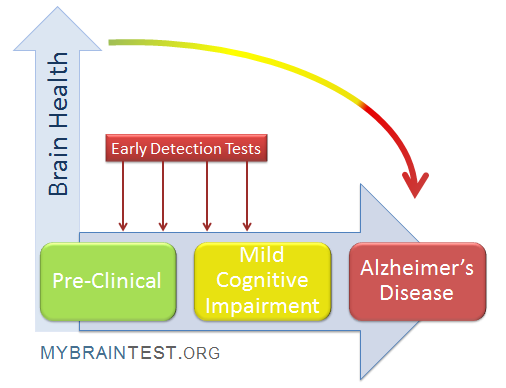Alzheimer’s early detection is becoming a crucial focus in the fight against neurodegenerative diseases, as researchers seek innovative ways to pinpoint cognitive impairment before it progresses. A groundbreaking study from Mass General Brigham highlights the potential of simple olfactory tests as a reliable method for identifying individuals at risk for Alzheimer’s disease. These tests, which allow participants to sniff various odors to assess their memory and identification abilities, have shown promising results when conducted at home. Findings revealed that older adults with cognitive impairment scored consistently lower on these olfactory assessments compared to their cognitively healthy peers. By prioritizing Alzheimer’s early detection through accessible home testing, researchers are paving the way for timely interventions that could alter the course of this devastating disease.
The significance of detecting Alzheimer’s disease early cannot be overstated, particularly as it offers a chance for intervention before cognitive decline becomes pronounced. This approach is further supported by research emphasizing the role of sensory loss, specifically olfactory dysfunction, in signaling potential cognitive issues. Researchers are exploring the efficacy of at-home assessment tools that measure the ability to recognize and remember scents, which may serve as early indicators of both Alzheimer’s and other neurodegenerative disorders. This promising avenue of study opens up opportunities not just for early diagnosis, but also for tailoring personalized treatment strategies. By advancing our understanding of cognitive impairment through innovative testing, we may enhance the quality of life for individuals facing these challenging conditions.
Understanding Alzheimer’s Early Detection
Alzheimer’s disease is a devastating neurodegenerative disorder that affects millions of individuals worldwide. Early detection has become a cornerstone of Alzheimer’s research and care, as it allows for timely interventions that could slow down the progression of cognitive decline. The recent advancements in olfactory testing mark significant progress in how we approach early detection. This innovative method taps into the sense of smell, which has been shown to decline in people at risk for Alzheimer’s, providing a noninvasive option for identifying cognitive impairment before overt symptoms appear.
Research has indicated that recognizing the risk factors and conducting early tests can make a substantial difference. The integration of at-home olfactory tests equips individuals and healthcare providers to monitor cognitive health effectively. By assessing odor identification and discrimination, we can gain valuable insights into an individual’s cognitive status. This proactive approach not only enhances early detection of Alzheimer’s but also raises awareness about neurodegenerative diseases, driving more people to seek evaluation and potential treatment options.
Frequently Asked Questions
What is Alzheimer’s early detection and why is it important?
Alzheimer’s early detection refers to identifying signs of cognitive impairment or Alzheimer’s disease before significant symptoms manifest. Early diagnosis is crucial as it enables timely intervention and management strategies that can help slow progression and improve quality of life.
How does the olfactory test work for Alzheimer’s early detection?
The olfactory test for Alzheimer’s early detection involves participants sniffing various odor labels on cards to assess their ability to identify and remember smells. Research shows that lower scores in these tests can indicate cognitive impairment in older adults, making it a potential early warning sign for Alzheimer’s disease.
Can home testing effectively aid in Alzheimer’s early detection?
Yes, home testing can effectively aid in Alzheimer’s early detection. The olfactory tests developed by researchers can be performed at home, allowing individuals to assess their olfactory function and potentially identify cognitive impairment without the need for clinical settings.
What are the benefits of using olfactory tests for Alzheimer’s early detection?
Olfactory tests for Alzheimer’s early detection are noninvasive, cost-effective, and easy to administer. These tests can help identify individuals at risk of neurodegenerative diseases early on, facilitating earlier intervention and potentially altering the course of cognitive decline.
How does cognitive impairment relate to Alzheimer’s disease?
Cognitive impairment is often one of the earliest signs of Alzheimer’s disease. It can manifest through difficulties in memory, thinking, and reasoning. Recognizing cognitive impairment early through tests like olfactory assessments is essential for timely management and support.
What role do neurodegenerative diseases play in Alzheimer’s early detection?
Neurodegenerative diseases, including Alzheimer’s, involve progressive degeneration of the nervous system. Early detection of these diseases, especially through tools like olfactory tests, helps identify at-risk individuals, allowing for targeted prevention strategies and ongoing research into therapeutic options.
Are olfactory tests reliable indicators of future Alzheimer’s symptoms?
Preliminary research suggests that olfactory tests can be reliable indicators of cognitive decline and risk for Alzheimer’s symptoms. Ongoing studies aim to validate these findings further and explore how well olfactory dysfunction can predict future neurological issues.
| Key Points |
|---|
| Researchers at Mass General Brigham have developed an at-home olfactory test to detect early signs of Alzheimer’s disease. |
| The test assesses the ability to discriminate, identify, and remember odors, with lower scores linked to cognitive impairment. |
| Older adults with mild cognitive impairment showed decreased odor identification and discrimination compared to cognitively normal individuals. |
| The study emphasizes a need for noninvasive, cost-effective methods for early detection of Alzheimer’s risk in diverse linguistic populations. |
| Future research will explore the predictive capabilities of olfactory testing alongside neuropsychological evaluations over time. |
Summary
Alzheimer’s early detection is crucial in managing and potentially delaying the onset of symptoms. The innovative olfactory test developed by researchers at Mass General Brigham allows for at-home assessment of smell discrimination and identification, acting as a preliminary indicator of cognitive impairment. This convenient method can help identify individuals at risk for Alzheimer’s disease well before any noticeable memory loss occurs. By addressing early detection, healthcare providers can implement interventions that may significantly improve the quality of life for those with early signs of Alzheimer’s.
